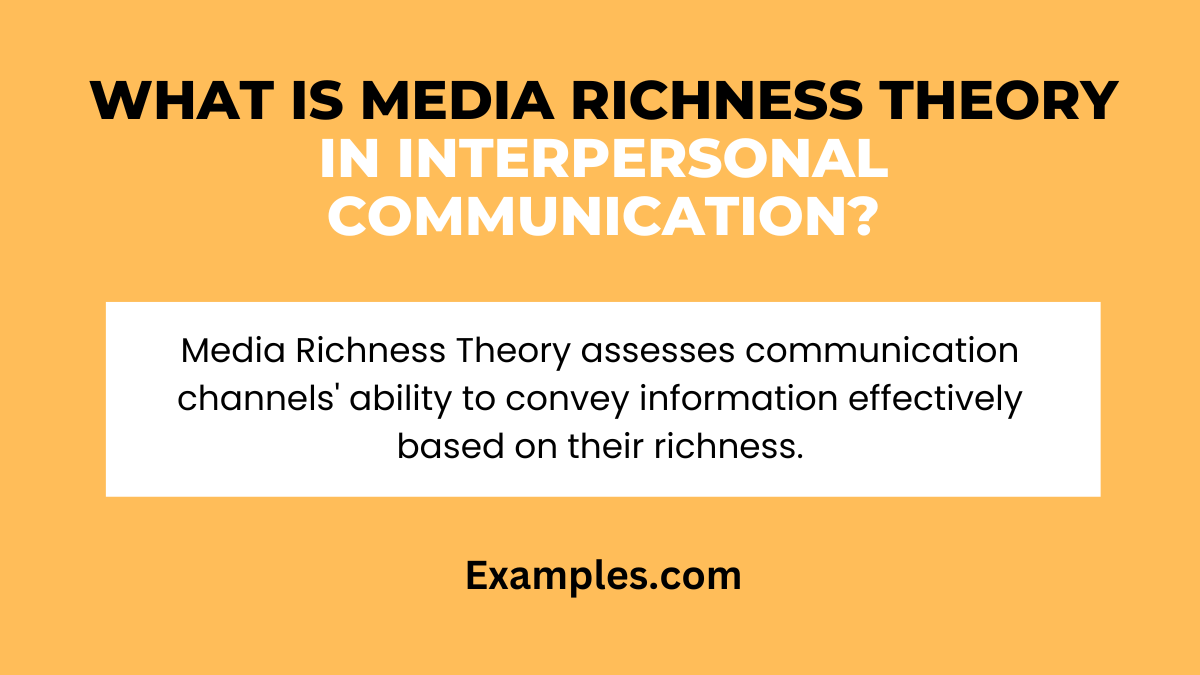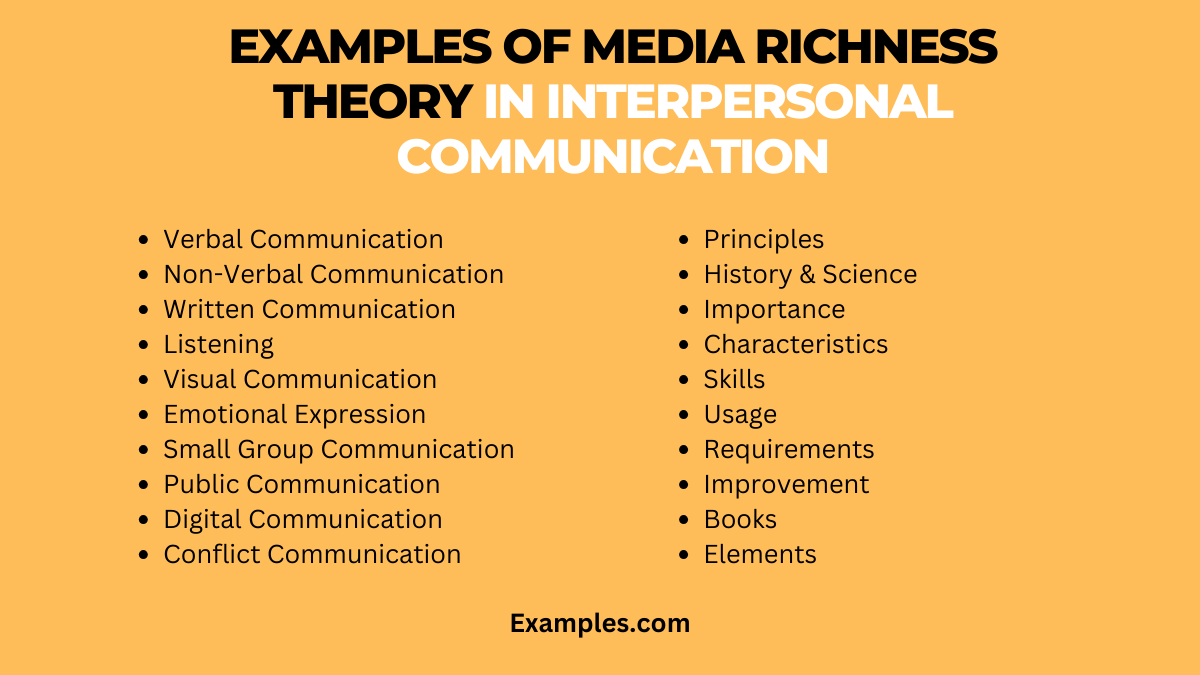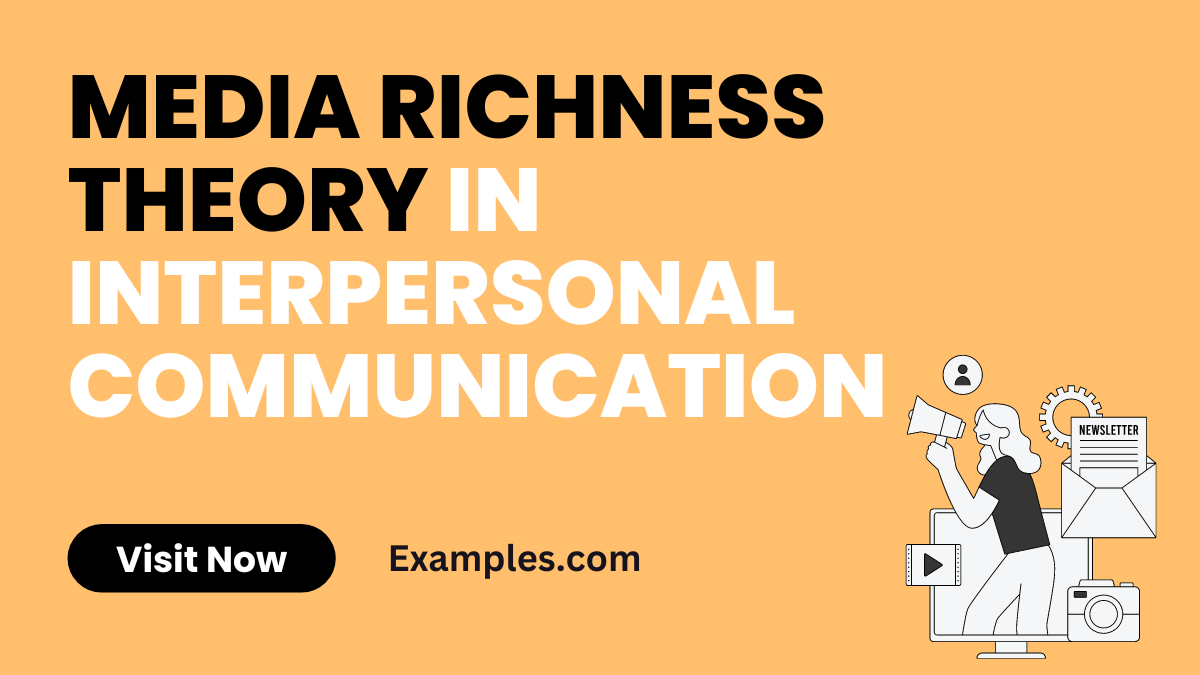19+ Media Richness Theory in Interpersonal Communication Examples
Interpersonal Communication is an essential aspect of our daily interactions, and understanding Media Richness Theory can greatly enhance this process. This theory examines how different communication mediums impact the quality and effectiveness of interactions. Our guide delves into various examples of Media Richness Theory in action, showcasing how choosing the right medium can lead to more meaningful and productive conversations. Whether it’s through digital platforms or face-to-face dialogues, understanding this theory is key to successful interpersonal communication.
What is Media Richness Theory in Interpersonal Communication?

Media Richness Theory is a crucial concept in Interpersonal Communication. It suggests that the effectiveness of communication depends on the richness of the medium used. Richer mediums, like face-to-face conversations, provide immediate feedback, convey multiple cues like tone and body language, and support personalization. This theory helps in choosing the most appropriate medium for effective communication, considering factors like complexity of the message and the need for personal connection.
History
Who Created: Richard L. Daft and Robert H. Lengel
Date: 1980
It emerged from the field of organizational communication, addressing how the choice of communication media affects the understanding of messages within organizations. This theory has since evolved, adapting to the introduction of new technologies and mediums in the realm of interpersonal communication, remaining a relevant and insightful tool for understanding and improving communication effectiveness.
What is the Best Example of Media Richness Theory in Interpersonal Communication?
A prime example of Media Richness Theory in Interpersonal Communication is the contrast between email and face-to-face meetings. While emails are effective for straightforward information exchange, complex and nuanced conversations often require the richness of in-person interactions. This allows for immediate feedback, interpretation of non-verbal cues, and a deeper emotional connection, which are vital for resolving conflicts, brainstorming sessions, or sensitive discussions.
20 Examples of Media Richness Theory in Interpersonal Communication

Media richness theory emphasizes the selection of appropriate communication channels to convey complex information effectively. It’s pivotal in enhancing Interpersonal Communication Skills and understanding the Types of Interpersonal Communication. This article explores 20 unique examples of media richness theory in diverse interpersonal communication scenarios, providing practical insights into how to effectively communicate complex ideas through the most suitable mediums.
- Verbal Communication in Interpersonal Communication: During team meetings, using verbal communication allows for immediate feedback and clarification of complex ideas.
Example: “Can you elaborate on your point about market trends?” - Non-Verbal Communication in Interpersonal Communication: Facial expressions and gestures can convey emotions effectively in one-on-one interactions.
Example: Nodding to show agreement during a colleague’s presentation. - Written Communication in Interpersonal Communication: Email is ideal for delivering detailed project updates, ensuring clarity and record-keeping.
Example: Sending a comprehensive project report via email. - Listening in Interpersonal Communication: Active listening in counseling sessions helps in understanding client’s concerns beyond words.
Example: “I hear you saying that you feel overwhelmed, is that correct?” - Visual Communication in Interpersonal Communication: Using infographics to explain complex data in business presentations. Example: “This chart illustrates the sales growth over the past year.”
- Emotional Expression in Interpersonal Communication: In intimate relationships, expressing emotions verbally can strengthen bonds. Example: “I feel happy when we spend quality time together.”
- Small Group Communication in Interpersonal Communication: Brainstorming sessions with a whiteboard facilitate collaborative and creative problem-solving.
Example: “Let’s all add our ideas to the board.” - Public Communication in Interpersonal Communication: Public speaking events use storytelling to connect with larger audiences on complex topics.
Example: “Let me share a story that highlights our environmental mission.” - Digital Communication in Interpersonal Communication: Social media platforms are effective for broadcasting messages to a wide audience.
Example: Posting an update on LinkedIn about a company milestone. - Interpersonal Conflict Communication: Face-to-face discussions in conflict resolution ensure transparency and understanding.
Example: “Let’s meet to discuss this issue and find a mutual solution.” - Principles of Interpersonal Communication: Teaching these principles through interactive workshops enhances learning and retention. Example: “Today’s workshop will involve role-playing different communication scenarios.”
- History & Scientific Study of Interpersonal Communication: Documentaries and lectures effectively convey the evolution of communication theories.
Example: “This documentary explores the historical context of communication theories.” - Importance of Interpersonal Communication: Seminars highlighting real-life case studies emphasize the significance of effective communication.
Example: “This case study shows how communication can make or break a team.” - Characteristics of Interpersonal Communication: Role-playing exercises in training sessions demonstrate various characteristics of communication styles.
Example: “In this role-play, observe the non-verbal cues used.” - Interpersonal Communication Skills: Workshops with interactive activities enhance the development of communication skills.
Example: “This activity will focus on improving your listening skills.” - How to Use Interpersonal Communication: Coaching sessions provide tailored advice on applying communication strategies in personal and professional life.
Example: “In our next session, we’ll focus on assertive communication techniques.” - What are Requirements for Interpersonal Communication: Online courses offer structured learning on the essentials of effective communication.
Example: “This online course covers the foundational elements of interpersonal communication.” - How to Improve Interpersonal Communication: Peer feedback in group discussions offers practical insights for improvement.
Example: “Let’s give each other constructive feedback on our communication styles.” - Interpersonal Communication Books: Reading comprehensive books on communication theories provides in-depth knowledge.
Example: “I recommend reading ‘The Art of Communicating’ for deeper insights.” - Elements of Interpersonal Communication: Interactive diagrams and models in educational materials aid in understanding the complex elements of communication.
Example: “This model illustrates the key elements of effective interpersonal communication.”
What are the Factors Affecting Media Richness Theory in Interpersonal Communication?
Media Richness Theory (MRT) plays a significant role in Interpersonal Communication. It’s essential to understand the factors influencing MRT to optimize communication strategies. Here are the key factors:
- Immediate Feedback: The capacity of a communication medium to allow immediate responses is crucial. Immediate feedback enables real-time clarification and adjustment of messages, enhancing the richness of the interaction.
- Cues Variety: This refers to the number of verbal and non-verbal cues that a medium can convey. For example, face-to-face communication offers gestures, facial expressions, and tone of voice, making it richer compared to text-based mediums.
- Personalization: The degree to which a medium allows for personalized messages. Personalized communication, like a one-on-one conversation, is typically richer than generic broadcast messages.
- Language Variety: The richness of a medium also depends on its capacity to handle natural language versus controlled or formal language. Conversational language typically carries more nuanced information than formal text.
- Emotional Expression: The ability of a medium to convey emotional information effectively. Channels that allow for emotional expression, such as video calls, are considered richer.
What are the 5 Criteria for Media Richness Theory in Interpersonal Communication?
Media Richness Theory in Interpersonal Communication is based on five key criteria:
- The Ability to Handle Multiple Information Cues: A rich medium can convey multiple cues like body language, tone, and facial expressions, providing a comprehensive understanding of the message.
- The Ability to Facilitate Rapid Feedback: Rich media enable quick responses, allowing for immediate clarification and interaction.
- The Capacity for Personalization: Media that can be tailored for individual interactions are considered richer. This personalization enhances the effectiveness of the communication.
- The Ability to Utilize Natural Language: Rich media support conversational language, which is more effective in conveying nuances and emotions than formal, structured language.
- The Ability for Emotional Expression: Media that can effectively transmit emotions are considered rich. Emotional expression is vital for building relationships and understanding in interpersonal communication.
What are the Functions of Media Richness Theory in Interpersonal Communication?
The Media Richness Theory serves several functions in interpersonal communication:
- Enhancing Understanding: By using rich media, individuals can convey and interpret messages more effectively, leading to better understanding.
- Reducing Ambiguity: Rich media help in clarifying ambiguous information, as they provide multiple cues and rapid feedback.
- Improving Decision Making: Effective communication through rich media supports better decision-making by providing comprehensive information.
- Building Relationships: Rich media facilitate emotional expression and personalization, which are crucial for building and maintaining relationships.
- Facilitating Complex Communications: When dealing with complex or sensitive information, rich media are more effective in ensuring the message is correctly understood and interpreted.
In mastering Interpersonal Communication, recognizing its vast scope and profound impact is key. Whether it’s through Digital Communication in our tech-driven world or traditional face-to-face interactions, the principles of effective interpersonal communication are pivotal. Embracing diverse methods—from verbal to non-verbal cues—enhances understanding and fosters stronger connections. To excel, delve into its rich history, explore varied styles, and continuously refine your skills for personal and professional growth.



